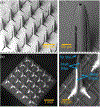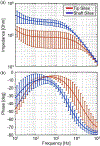Fabrication of Out-of-Plane High Channel Density Microelectrode Neural Array with 3D Recording and Stimulation Capabilities
- PMID: 39239464
- PMCID: PMC11376443
- DOI: 10.1109/jmems.2020.3004847
Fabrication of Out-of-Plane High Channel Density Microelectrode Neural Array with 3D Recording and Stimulation Capabilities
Abstract
The Utah Electrode Array (UEA) and its different variants have become a gold standard in penetrating high channel count neural electrode for bi-directional neuroprostheses (simultaneous recording and stimulation). However, despite its usage in numerous applications, it has one major drawback of having only one active site per shaft, which is at the tip of the shaft. In this work, we are demonstrating a next-generation device, the Utah Multisite Electrode Array (UMEA), which is capable of having multiple sites around the shaft and also retaining the site at the tip. The UMEA can have up to 9 sites per shaft (hence can accommodate 900 active sites) while retaining the form factor of the conventional UEA with 100 sites. However, in this work and to show the proof of concept, the UMEA was fabricated with one active site at the tip and two around the shaft at different heights; thus, three active sites per shaft. The UMEA device is fabricated using a 3D shadow mask patterning technology, which is suitable for a batch fabrication process for these out-of-plane structures. The UMEA was characterized by in-vitro tests to showcase the electrochemical properties of the shaft sites for bi-directional neuroprostheses in contrast to the traditional tip sites of the standard UEA. The UMEA not only improves the channel density of conventional UEAs and hence can access a larger population of neurons, but also enhances the recording and stimulation capabilities from different layers of the human cortex without further increasing the risk of neuronal damage.
Keywords: Microelectrodes; Neural Electrodes; Shadow Mask; Utah Electrode Array; Utah Multisite Electrode Array.
Figures








Similar articles
-
Reusable High Aspect Ratio 3-D Nickel Shadow Mask.J Microelectromech Syst. 2017 Apr;26(2):376-384. doi: 10.1109/JMEMS.2017.2654126. Epub 2017 Feb 8. J Microelectromech Syst. 2017. PMID: 29056835 Free PMC article.
-
Advances in Penetrating Multichannel Microelectrodes Based on the Utah Array Platform.Adv Exp Med Biol. 2019;1101:1-40. doi: 10.1007/978-981-13-2050-7_1. Adv Exp Med Biol. 2019. PMID: 31729670 Review.
-
Wafer-scale fabrication of penetrating neural microelectrode arrays.Biomed Microdevices. 2010 Oct;12(5):797-807. doi: 10.1007/s10544-010-9434-1. Biomed Microdevices. 2010. PMID: 20480240
-
Chronic recording and electrochemical performance of amorphous silicon carbide-coated Utah electrode arrays implanted in rat motor cortex.J Neural Eng. 2019 Aug;16(4):046006. doi: 10.1088/1741-2552/ab1bc8. Epub 2019 Apr 23. J Neural Eng. 2019. PMID: 31013489
-
A Molecular Perspective on Understanding and Modulating the Performance of Chronic Central Nervous System (CNS) Recording Electrodes.In: Reichert WM, editor. Indwelling Neural Implants: Strategies for Contending with the In Vivo Environment. Boca Raton (FL): CRC Press/Taylor & Francis; 2008. Chapter 6. In: Reichert WM, editor. Indwelling Neural Implants: Strategies for Contending with the In Vivo Environment. Boca Raton (FL): CRC Press/Taylor & Francis; 2008. Chapter 6. PMID: 21204400 Free Books & Documents. Review.
Cited by
-
Effect of microfluidic channel integration onto gold microelectrode on its redox electrochemistry.Turk J Chem. 2022 Dec 7;47(1):232-241. doi: 10.55730/1300-0527.3532. eCollection 2023. Turk J Chem. 2022. PMID: 37720855 Free PMC article.
-
Neuronal activity in the ventral tegmental area during goal-directed navigation recorded by low-curvature microelectrode arrays.Microsyst Nanoeng. 2024 Oct 14;10(1):145. doi: 10.1038/s41378-024-00778-2. Microsyst Nanoeng. 2024. PMID: 39396959 Free PMC article.
-
Highly stretchable and customizable microneedle electrode arrays for intramuscular electromyography.Sci Adv. 2024 May 3;10(18):eadn7202. doi: 10.1126/sciadv.adn7202. Epub 2024 May 1. Sci Adv. 2024. PMID: 38691612 Free PMC article.
References
-
- Benabid A-L, Pollak P, Louveau A, Henry S, and De Rougemont J, “Combined (thalamotomy and stimulation) stereotactic surgery of the VIM thalamic nucleus for bilateral Parkinson disease,” Stereotactic and functional neurosurgery, vol. 50, no. 1–6, pp. 344–346, 1987. - PubMed
-
- Odekerken VJ et al., “GPi vs STN deep brain stimulation for Parkinson disease: three-year follow-up,” Neurology, vol. 86, no. 8, pp. 755–761, 2016. - PubMed
-
- Baizabal-Carvallo JF, Kagnoff MN, Jimenez-Shahed J, Fekete R, and Jankovic J, “The safety and efficacy of thalamic deep brain stimulation in essential tremor: 10 years and beyond,” J Neurol Neurosurg Psychiatry, vol. 85, no. 5, pp. 567–572, 2014. - PubMed
-
- Benabid AL et al., “Long-term suppression of tremor by chronic stimulation of the ventral intermediate thalamic nucleus,” The Lancet, vol. 337, no. 8738, pp. 403–406, 1991. - PubMed
-
- Boccard SG et al., “Targeting the affective component of chronic pain: a case series of deep brain stimulation of the anterior cingulate cortex,” Neurosurgery, vol. 74, no. 6, pp. 628–637, 2014. - PubMed
Grants and funding
LinkOut - more resources
Full Text Sources
